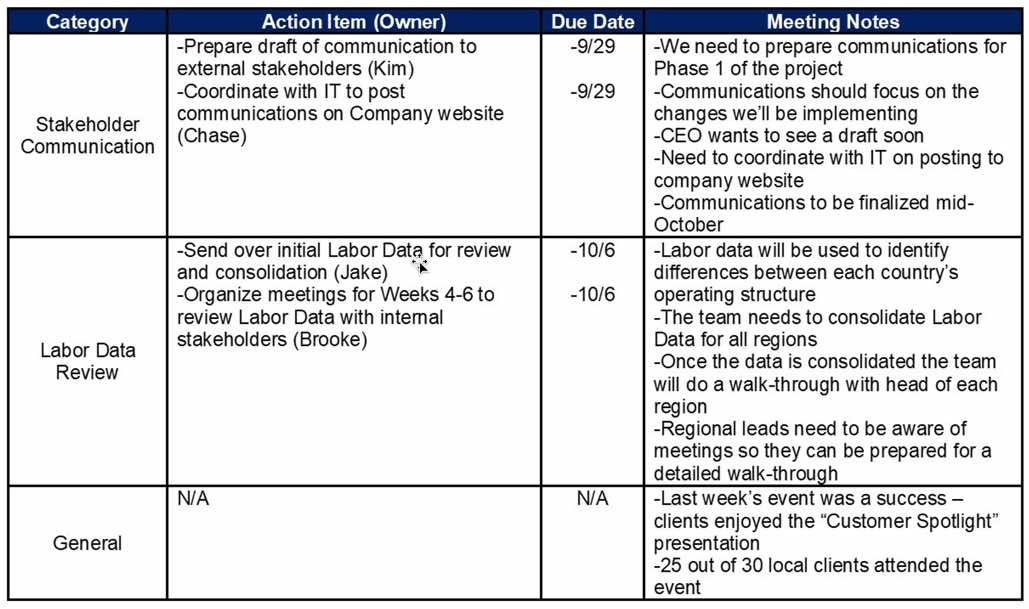As consultants, we are required and recommended to take notes for the meetings we attend. This seems like a simple task because formal education has forced us, at one time or another, to take notes. The world of formal education, however, is typically parsed out so an individual only needs to focus on one subject at a time.
Meetings in a ‘professional setting’ on the other hand, can be complex – they can be long and very detail-oriented. Multiple people can speak at the same time. If an individual is not prepared or if she does not have prior knowledge of the subjects that are discussed, she can get stuck trying to process what is being said while simultaneously taking notes – the result being incomplete or fragmented notes. This is not acceptable in a fast-paced or demanding environment and a better approach is required.
The Verbatim Approach
Fortunately, there is a fool-proof approach to taking notes. It works for all kinds of meetings, but it is most useful for long or very detail-oriented meetings. All that is required is for you to have a general understanding of typing (and access to a computer).
1. Record names of attendees or key stakeholders
During the first 5-10 minutes of the meeting, note down the participants or relevant stakeholders. You might not need this specific information, but it might help you later if you need to identify who is who during the meeting.
Note: Microsoft Office Suite provides a Meeting Notes function that automatically populates a note template in One Note with meeting attendees.
2. Record dialogue verbatim; note who’s speaking and any action items
As the meeting gets going, type out what you hear verbatim (or as close to verbatim as possible). You can paraphrase if the speed of the conversation is too quick to transcribe. Don’t worry about correcting typos as they occur – just worry about capturing as much dialogue as you can.
When the conversation switches from person to person, if you know who’s speaking, you can quickly type their name as you’re noting what they’re saying. You can note the person’s name before or at the end of the conversation. Below are some examples:
When someone begins to list a “to-do” or action item, you can identify it in any way that will call attention to it – highlighting and bolding works well. If at the end of the meeting you need to list out action items, you can quickly identify them. For example:
You can apply the “(Name)” and “(Action)” logic to whatever is most relevant to your domain or line of work – anything that helps you remember. Below are some examples:
Note: It’s helpful to have a predefined style set out before you begin taking notes so you don’t have to decide in the thick of it. You can use symbols or color schemes to easily identify specific actions or decisions later.
3. Organise your notes into a logical order
After the meeting is over, clean up any typos and check your notes for logical flow. Even if you didn’t initially understand everything that was being discussed, most meetings have some kind of logical flow to them. Usually, you can “bucket” different aspects of a meeting together. If possible, work with someone else that attended the meeting to fill in any gaps you might have missed and to answer any questions you might have had.
4. Summarise your notes in a table
Once you have all your notes squared away, start bucketing your notes into a table format similar to the one below:
When you’re finished, embed the table in the body of your email. DO NOT include the table as an attachment. Make it as easy as possible for people to process the information. A table helps you accomplish this by organizing information in a structured way that’s easy to comprehend. Embedding your table shortens the steps required for your message to reach its target audience.
Jason Oh is a Senior Associate at Strategy&. Previously, he was part of the Global Wealth & Asset Management Strategy team of a large financial institution and served EY and Novantas in their strategy consulting business with industry focus in the financial services sector.
Image: Pexels
Follow us now on LinkedIn.





